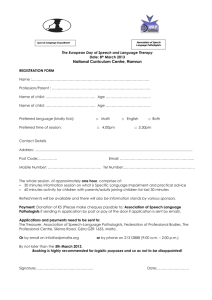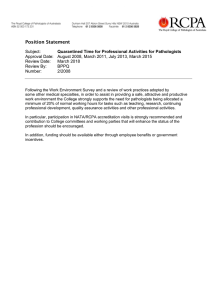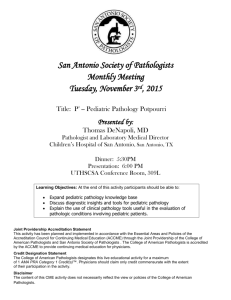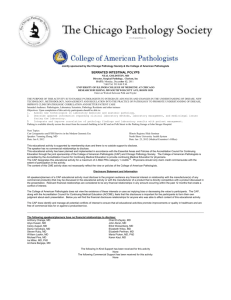without borders PATHOLOGISTS
advertisement
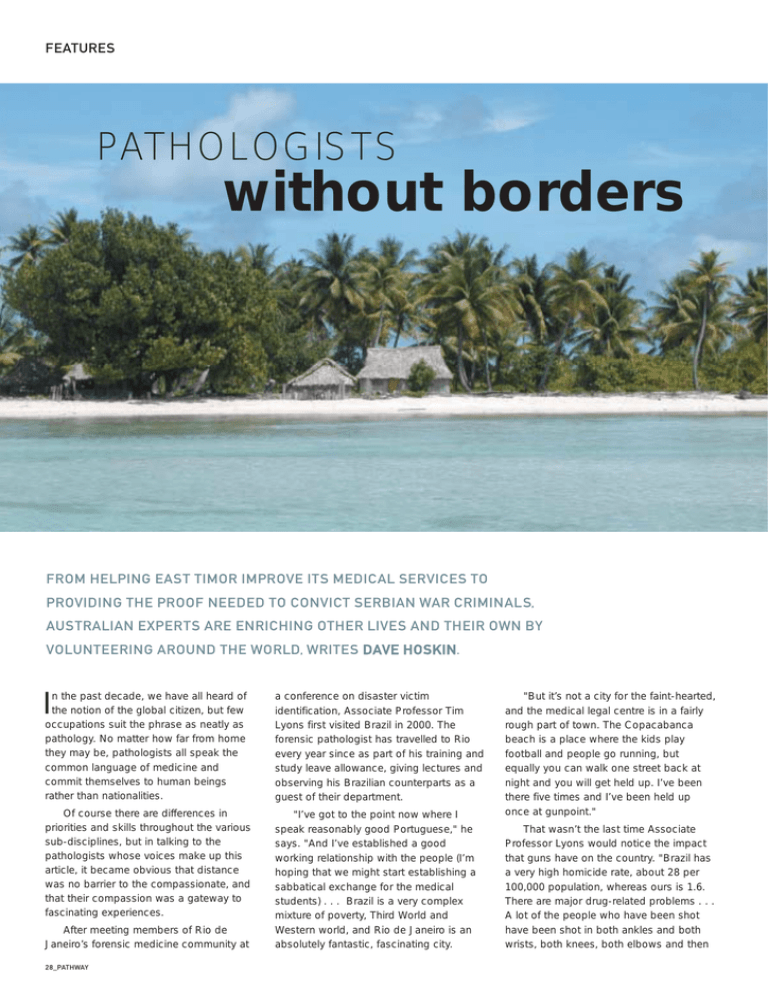
FEATURES PATHOLOGISTS without borders FROM HELPING EAST TIMOR IMPROVE ITS MEDICAL SERVICES TO PROVIDING THE PROOF NEEDED TO CONVICT SERBIAN WAR CRIMINALS, AUSTRALIAN EXPERTS ARE ENRICHING OTHER LIVES AND THEIR OWN BY VOLUNTEERING AROUND THE WORLD, WRITES DAVE HOSKIN . I n the past decade, we have all heard of the notion of the global citizen, but few occupations suit the phrase as neatly as pathology. No matter how far from home they may be, pathologists all speak the common language of medicine and commit themselves to human beings rather than nationalities. a conference on disaster victim identification, Associate Professor Tim Lyons first visited Brazil in 2000. The forensic pathologist has travelled to Rio every year since as part of his training and study leave allowance, giving lectures and observing his Brazilian counterparts as a guest of their department. Of course there are differences in priorities and skills throughout the various sub-disciplines, but in talking to the pathologists whose voices make up this article, it became obvious that distance was no barrier to the compassionate, and that their compassion was a gateway to fascinating experiences. "I’ve got to the point now where I speak reasonably good Portuguese," he says. "And I’ve established a good working relationship with the people (I’m hoping that we might start establishing a sabbatical exchange for the medical students) . . . Brazil is a very complex mixture of poverty, Third World and Western world, and Rio de Janeiro is an absolutely fantastic, fascinating city. After meeting members of Rio de Janeiro’s forensic medicine community at 28_PATHWAY "But it’s not a city for the faint-hearted, and the medical legal centre is in a fairly rough part of town. The Copacabanca beach is a place where the kids play football and people go running, but equally you can walk one street back at night and you will get held up. I’ve been there five times and I’ve been held up once at gunpoint." That wasn’t the last time Associate Professor Lyons would notice the impact that guns have on the country. "Brazil has a very high homicide rate, about 28 per 100,000 population, whereas ours is 1.6. There are major drug-related problems . . . A lot of the people who have been shot have been shot in both ankles and both wrists, both knees, both elbows and then In the laboratory at Kiribati, a small country of atolls in the South Pacific where the population has no histology service. In the general laboratory there, it was like working in a laboratory at the first stage of automation as in the 1970s. shot in the back of the head; they’re drugrelated assassinations. (In Australia) I see a few gunshot wounds a year, and yet in Brazil I might see 40 homicides on a Saturday. might be making legal claims. He says of "The police and the forensic community are very well structured. They don’t have dedicated forensic pathologists like myself . . . they run a team of eight doctors per day who come from other walks of life; four days a week they might be a surgeon and one day a forensic pathologist. would probably kill most of us. It’s a "They undertake post-mortems. They run a medical legal clinic, so they see people who’ve been raped or injured or been in motor vehicle accidents who pathology lab in the city of Patan. It was the forensic institute in Rio: "They’re not practising second-rate medicine by any means and I think that they cope very well with a massive throughput of work that wonderful emerging country." Histopathologist Dr David Evans, whose area of pathology is concerned with tissue changes characteristic of disease, travelled to the roof of the world, Nepal, in 2001 to do voluntary work in the not a decision he made lightly, as the palace massacre in which most of the royal family was killed had only recently occurred and there were concerns about further violence. However, after consulting a contact in Nepal, Dr Evans and his wife decided to make the journey. "It was 10 days after the massacre that we arrived, but we didn’t feel unsafe there . . . "The equipment was very basic, but fortunately in histopathology standard oldstyle equipment is very serviceable, and although we might miss out on the newer tests etc, standard pathology can be done. In the general laboratory there, it was like working in a laboratory at the first stage of automation as in the 1970s, where the very first automated machines for haematology etc were being used." PATHWAY_29 You see diseases that were common in Australia and in other Western countries at the turn of the last century, such as TB, high incidence of infant mortality from diarrhoea and infectious diseases. Unlike in Australia, tuberculosis is rife in Nepal. "I would have seen tuberculosis in almost every part of the body during my time there; bone, gut, skin, uterus," Dr Evans says.. "Typhoid fever is common, and some people get perforation of the bowel due to typhoid . . . There’s leishmaniasis (an infection caused by a parasite) and leprosy, and I saw a lot of advanced cancers. "Cancer of the cervix is preventable in our society, but the idea of screening a population with Pap smears is just not there (in Nepal), and it’s a very expensive thing to bring in. But it will no doubt come one day. It’s like medicine anywhere; you do what you can, and the best that you can do. "The people themselves are fascinating. I am always fascinated by another culture, and they’re lovely people: hardworking, busy, keen to meet you and see what you’re doing. They’re interested in you and therefore you are interested in them. "I always see (overseas volunteer work) as an exciting new adventure, and that in itself is a challenge: to do what you can in a reasonable way. You could get overwhelmed by the need when you compare it with what’s available back home. Helping other people to make progress and to come to terms with their situation, I think, is the most challenging and rewarding thing that there is, and they are so appreciative of what you do." When Dr Evans was researching how to find volunteer work overseas, the name that was recommended was Associate 30_PATHWAY Professor Stephen Weinstein. A fellow histopathologist as well as director of pathology on the Gold Coast, Associate Professor Weinstein has subsequently worked closely with Dr Evans, and they share a particular interest in helping the people of East Timor (the two men are currently trying to gather histology equipment that can be donated to Dili National Hospital’s pathology department). Associate Professor Weinstein has also visited places such as Madagascar and Kenya. Describing how volunteer groups such as Pathologists Overseas help make such journeys possible, he says: "The way that (Pathologists Overseas) works is, you pay your own airfare and they supply accommodation. The work can involve different things; for example, in Madagascar it involved training registrars, which are pathology trainees, and they didn’t have anybody else to do that over there. "Madagascar, to give you an idea, is an enormous country, it’s got a population of 12 million and it’s got three functioning anatomic pathologists. Australia’s got a population of just under twice that and they’ve got 1250." An even more challenging place to work is Kiribati, a small country of atolls in the South Pacific. Associate Professor Weinstein handles their histology specimens for them voluntarily. "The average income there is only about $800 per person, per year. There’s no tourism because the place is so remote . . . But it’s certainly very rewarding to do their histopathology for them because they could not have it done anywhere else; they have no other access to the service." As well as Kiribati, Associate Professor Weinstein is also part of a network of volunteers that conducts histopathology for East Timor, a country that he says is getting back on its feet. "The laboratory in Dili, when I was there two years ago, they only did manual haematology, manual blood counts, very basic manual biochemistry. They could culture bacteria and they could transfuse blood, which they screened for diseases. They could not do any histopathology . . . The St John of God organisation is currently undertaking a refurbishment of the laboratory, which is going to be a big help." He says working in a foreign country provides a different perspective. "You see a totally different spectrum of disease to start with. You see diseases that were common in Australia and in other Western countries at the turn of the last century, such as TB, high incidence of infant mortality from diarrhoea and infectious diseases. Parasitic diseases are fairly uncommon in Australia . . . whereas places like East Timor have got a very high incidence of parasitic infections. Most of Photographs from Ass. Professor Stephen Weinstein’s personal collection from his time in Kiribati. those diseases have to do with hygiene and living standard, more than they do with climatic conditions". twice. It made it more difficult because we then had to work out how many individuals there were present. on a huge scale. I just wondered, how would I cope seeing death on this sort of scale?" Violence, whether it is to do with Nepalese Maoist rebels, Indonesian militias or Brazilian drug warfare, is a common undercurrent in the stories of all the pathologists I spoke to. In my conversation with forensic pathologist Dr Chris Lawrence, however, violence lurched sickeningly into the foreground. "It ranged from being whole bodies to parts of bodies: a big jigsaw puzzle. Trying to detect gunshot injuries in skeletons is not easy, and then when you break them up, even more so. They were killing people on a massive scale, so they had to use earth-moving equipment to really move bodies around. What had happened was everybody knew about the massacre, but there were no bodies, so people were saying, ‘Well, what’s your evidence?’ Despite all the horror, Dr Lawrence stresses the positive feeling that surrounded the multinational investigation, and is quick to praise the team spirit of his fellow workers. He agrees the camaraderie helped offset the enormity of the task, as did the sense something was being done for the greater good. "It’s also fascinating work from an intellectual point of view: the difficulty of working out, with bones alone, what actually happened. In the dying days of Slobodan Milosevic’s regime, Serbian troops rounded up 7000 Muslims, massacred them, and then buried the bodies in multiple mass graves. When evidence of these massacres was presented to the United Nations Security Council, the Serbs sought to rebury the bodies under cover of darkness in an attempt to circumvent the impending probe. As part of a team charged with investigating these war crimes, it was Dr Lawrence’s unenviable task to prove what had happened in the Bosnian town of Srebrenica. "We actually had bodies that had not just been buried once, but buried "There were so many displaced people that you could say there were 7000 missing people, but you had to prove that there was at least a sizeable number (murdered and then buried at Srebrenica)." Dr Lawrence did not join the investigation without misgivings. "I think one of the things is that you contemplate how evil this sort of stuff is. The killing of this huge number of people, it seems like a crime of . . ." He pauses to consider. "Murder’s never nice, but this is a crime "The greatest thing for me was to go and do the work for six months, and then go and give evidence, and then a year later the guy gets sentenced to 48 years in prison. You sort of feel . . . we’ve done our bit. These guys thought they could get away with it and at least we could say to the families, ‘These guys are not going to get away with it. They are going to be trapped, and brought to trial and they will answer for what they’ve done in court.’ From those points of view, it was a very positive experience." PATHWAY_31


